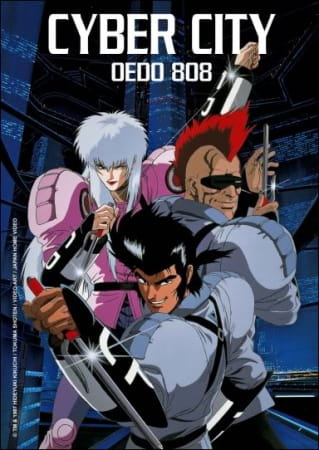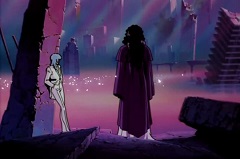
Cyber City Oedo 808
Ex-cons being forced into fighting for the forces of good is nothing new in storytelling. It can make for a fun approach to crime fighting as shady characters resort to unconventional methods of achieving their goals, though. Cyber City Oedo 808 does this reasonably well as a trio of convicts are forced to work for the city’s police force with the alternative being that their heads will get blown off by explosive collars strapped around their necks. With suitable motivation, these three individuals are thrust into an equal number of OVAs where each is the center of their own story while the others help out. They’re entertaining little adventures where aesthetic and action carry the experience, and while some of the characters are rather archetypal, there are others that are actually pretty unique, adding to the experience.Taking place in the early 2800s, there is all sorts of nifty technology in Oedo City. This heavily impacts the direction the OVAs' stories take. There are three ex-cons who have been pressed into service. Sengoku is your typical tough guy. He solves problems with his fists and a gun. Point him in the direction of a baddie and he’ll pump them full of bullets. Gabimaru is a tech wiz who can work wonders on a computer. He’s actually the biggest, brawniest of the three, but is more of a gentle giant who prefers using his intellect to solve problems. Finally, there is Merill, who appears to be modelled after the visual kei aesthetic that was popular in the Japanese music industry of the late 80s / early 90s. He has puffy, long hair, lipstick, and talon-like painted nails. He has a slender, feminine physique, and is very agile, using a metal wire hidden in a ring to slice up enemies. The three of them work for their police taskmaster, Hasegawa, who seems to mostly be around to remind them that if they screw up, their heads will explode.
Each of the three gets their own OVA to star in, while the other two provide backup. The first follows Sengoku as he investigates how a massive, technologically advanced skyscraper’s systems are being threatened. Hacking in has proven a challenge, so he’s been tasked with infiltrating the building, fighting off resistance, and finding who is responsible. The second episode centers around Gabimaru. The military hasn’t had any good wars to wage of late, so they took it upon themselves to develop a cybernetic super soldier to fight crime with. As Gabimaru investigates, it turns out that the army haven’t been very honest with government and the authorities as to what they’ve been up to, and it’s up to him to stop their plans. Last, but not least, Merill is sent to look into some mysterious murders only to discover that there’s a 300 year old psychic vampire on the loose.
The little adventures in every episode are fun, largely action-oriented affairs. They’re only about 40 minutes each, so there isn’t a huge amount of time that can be spent crafting a complex plot. Most of what happens is pretty typical of anime to come out in the early 90s. That each episode has its own flavor reflecting the very different personalities of the convicts helps keep things fresh, preventing the stories from becoming stale or repetitive.
One of the big selling points of the shows is the art, as it’s very nice. Obviously, there’s a lot of futuristic imagery here with steel skyscrapers thrusting into the sky, massive highways, futuristic cars, cybernetics, space elevators and so forth. They all have a nice look to them, and there are some well put together set pieces from time to time. The ruins where Merill meets Remi is a particularly nice stand out, as there’s an interesting mix of crumbling buildings offset by a glistening pink lake that has flooded the area. Meanwhile, character design is very well done with obvious 80s influence in terms of hair styles and attire.
It’s also worth noting that there are two versions of the soundtrack. Japan and America got one iteration with Japanese pop singers handling the music for the opening and closing credits. They also had different incidental music throughout. Meanwhile, the UK version has its own completely reworked score. The pop songs are gone, and music during the episodes have much more brooding padded synths. Both soundtracks have their charms, but many will likely gravitate toward one or the other depending where their tastes lay.
Thirty years on, Cyber City Uedo 808 doesn’t get a lot of attention in this day and age, which is unfortunate as its quite an enjoyable trio of OVAs. It looks good, sounds good, and has some reasonably interesting characters that go on some fun adventures. The series is well worth checking out.
- IroIro
May 1, 2020
More Futuristic Anime:
- Dominion Tank Police Anime Review- Bounty Dog Anime Review
- Cosmo Police Justy Anime Review
Studio: Madhouse
Released: 1990 / 91
Episodes: 3

VHS Cover Art

Gabimaru runs into trouble

Sengoku doing what he does best: shooting stuff

A rather pretty scene